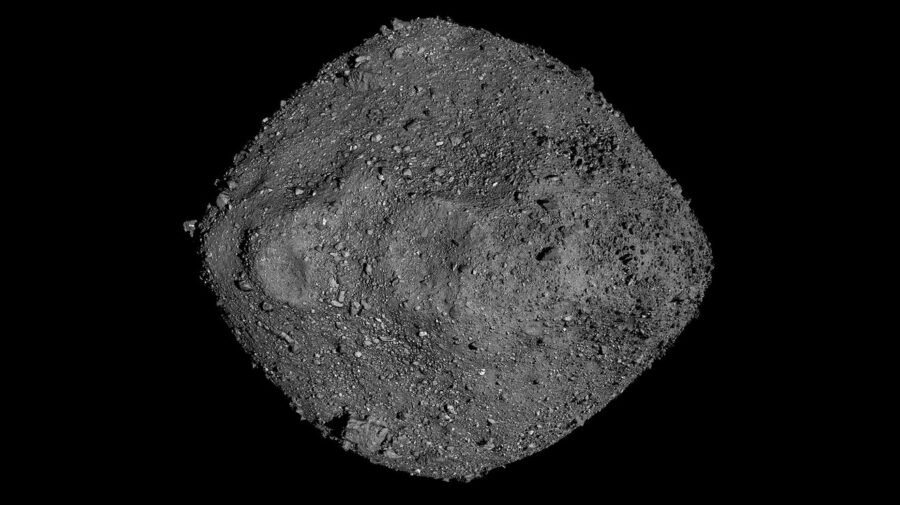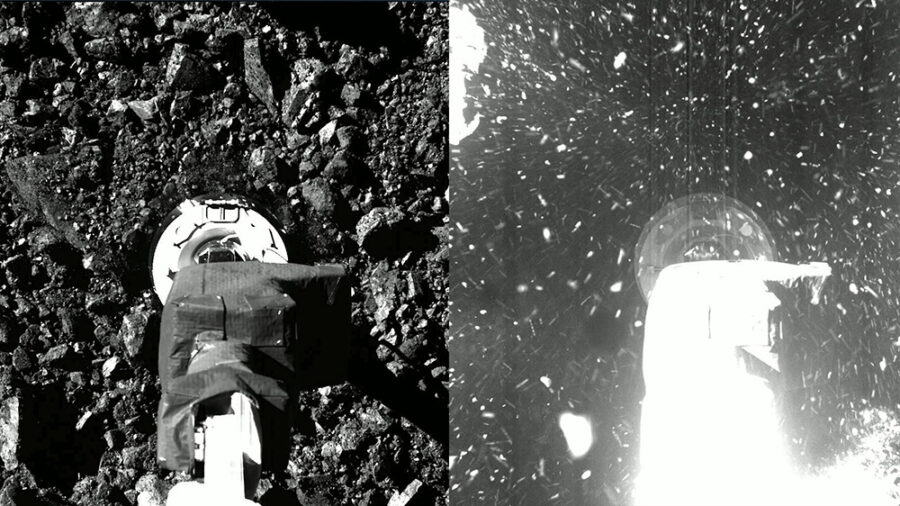OSIRIS-REX’s visit to the asteroid Bennu revealed that this little world is more rubble pile than solid rock.

NASA GSFC / University of Arizona
Rubble piles in space aren't like the solid ones that gravity holds on the ground. New analysis shows that NASA's OSIRIS-REX probe punched right through the surface of rubble-pile asteroid 101955 Bennu while on its way to collect a sample. If the probe hadn’t been programmed to lift itself back into orbit a few seconds after landing, the half-kilometer asteroid could have swallowed it whole.
The asteroid is so loosely bound that the brief jet of gas that was supposed to blow surface material into the collection hopper instead blasted out 6,000 kilograms (13,000 pounds) of dust and rock, says OSIRIS-Rex team member Cat Wolner (University of Arizona). Ultimately, the team estimates the probe was able to fill its hopper with 250 grams of material to take home.
Although the first images from OSIRIS-REX’s sampling maneuver on October 20, 2020, took only 18 minutes to reach Earth, it took time for the team to sort out what had happened during the brief touch-and-go. Their immediate goal was to secure at least 60 grams of surface material for delivery to Earth in 2023. In papers posted online July 8th in Science and Science Advances, team members describe how the unexpected outburst of dust and rock nearly choked the probe, while giving us new insight on rubble-pile asteroids.

NASA's Goddard Space Flight Center
When OSIRIS-REX arrived at Bennu at the end of 2018, planetary scientists initially expected to find a mostly dusty surface. Instead, the probe found a rough and rocky world with few options for landing.
From surface images, the OSIRIS-REX team selected a 20-meter-wide crater as the best sample target. A 3.35-meter articulated arm attached to the probe unfolded to deploy an aluminum collection head; together, these pieces are called the Touch and Go Sample Acquisition Mechanism (TAGSAM). The probe approached the surface that October 20th at a slow 10 cm/s (0.2 mph).
NASA Goddard / University of Arizona
The plan was then for the TAGSAM head to touch the surface and stay there for five seconds while a jet blew nitrogen gas into surface material, swirling it up for collection by the head. The spacecraft would then slowly lift off the asteroid with the sample and return to orbit.
However, TAGSAM didn't stop when it touched the surface. It kept on going, pushing another half-meter down before the spacecraft reversed course, lifting the mechanism upward through the blasted-out dust and particles. Some material stuck to the spacecraft as well as to the TAGSAM.
Looking down as it departed, the spacecraft saw an elliptical crater nine meters long. That image and the burst of dust startled the team. Lab tests of the sampling procedure “barely made a divot,” said principal investigator Dante Lauretta (University of Arizona) in a statement. “What we saw was a huge wall of debris radiating out from the sample site. . . . We were like, ‘Holy cow!’” Nobody had expected the delicate sampling process to blast 6 metric tons upward.
Fortunately, the instruments kept working as dust and debris spewed over the spacecraft. Wolner was impressed. “We were able to get a direct spectrum from the particles that landed on the spectrometer optics,” she said. Those readings confirmed other measurements: Bennu includes carbonaceous materials like those of the most primitive meteorites but with a history of interacting with water.
The debris left the TAGSAM collector overflowing, with some large particles preventing the cover from closing until some particles were carefully shaken out. Eight days after collecting the sample, closing the collector left an estimated 250 grams inside for laboratory analysis.
NASA’s Goddard Space Flight Center / CI Lab / SVS
Further analysis of Bennu showed that no cohesion or other force holds the outer layers of Bennu in place except the asteroid’s feeble gravity. In Lauretta's words, “the particles making up Bennu's exterior are so loosely packed and lightly bound to each other that they act more like a fluid than a solid.”
Few other rubble-pile asteroids have received such close scrutiny. Most recently, Japan's Hayabusa2 spacecraft found little dust on the boulder-strewn surface of 162173 Ryugu, a 1-kilometer-wide rubble pile similar to Bennu in both shape and composition. Hitting that near-Earth asteroid with a two-kilogram copper pellet at 2 km/s (4,500 mph) left a more than 10-meter crater — a big hole for such a small bullet.
Close examination of other small rubble-pile asteroids also shows little dust, write Hsiang-Wen Hsu (University of Colorado, Boulder) and colleagues in Nature Astronomy. They used laboratory experiments to study why, finding that static electricity makes dust jump like popcorn, ejecting most dust from kilometer-size asteroids within a few million years.
University of Colorado, Boulder
Observations of Bennu so far have shown this near-Earth asteroid is a strange world of its own right. The 5.4-gram sample returned from Ryugu in December 2020 by Hayabusa2 is now being studied. Analysis of the much larger Bennu samples, to be returned to Earth late next year, will reveal further details. These rubble piles promise to yield new scientific treasures.
 5
5









Comments
Anthony Barreiro
July 15, 2022 at 7:27 pm
What does this finding portend for the fantasy of planetary defense against a large asteroid on a collision course with Earth? If the asteroid is a frictionless rubble pile held together only by its very weak gravity, what good would it do to hit it with a projectile, as in the upcoming DART mission? Would the projectile just plow through the asteroid, leaving a more turbulent but no less dangerous rubble pile in its wake? Would a slow and steady gravity tractor approach have a greater chance of diverting a rubble pile?
You must be logged in to post a comment.
Bob-dBouncier
July 16, 2022 at 1:49 pm
Analysis will have to be done to see if such a rubble pile would more easily disintegrate in the atmosphere, or bounce off, depending on the approach angle.
You must be logged in to post a comment.
Tom Kellogg
July 16, 2022 at 8:21 pm
Good to see your comment/questions Anthony. I will add to this by wondering what would happen if Bennu or such a loose pile of frictionless rubble pile struck Earth, assuming it has no solid rock core. I imagine it would blast out and hit as a wild meteor storm lighting up the sky across the entire diameter of the Earth. Most or all of the particles would evaporate before reaching the Earth's surface if they are all tiny particles. Could we be darkened by dust for some weeks/months/years?
You must be logged in to post a comment.
RMP
July 19, 2022 at 1:02 pm
If its all cohesionless rubble, seems like it would be pulled apart by Earth tidal forces once inside the Roche limit. Depending on the approach angle & velocity and lunar grav. it might pass, it could form a ring of rocky-sandy debris around Earth. If there is a 'hard-core' in there, that part could impact depending on size and density. i.e., it makes planning for any 'planetary defense' extremely complicated. Since nothing like it has yet formed a ring around Earth in 3.5 billion years, it seems to be a very unlikely extremely rare event. So maybe not something to 'worry about' compared to more NEO solid bodies.
You must be logged in to post a comment.
Martian-Bachelor
July 20, 2022 at 7:32 pm
To me the real issue now, if there's no internal cohesion, is how you get anything but a nice spherical shape for the asteroid, even under the exremely low (but non-zero) amount of self-gravity.
What's making it boxy? Something has to be holding up the corners.
You must be logged in to post a comment.
You must be logged in to post a comment.